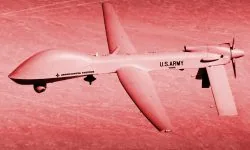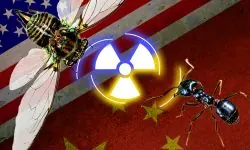(Art direction: Jean-Dominique Lavoix-Carli)
Combat robots, AI targeted air strikes, new generation cyber and information warfare, AI generated deep-fakes, unmanned air and sea military vehicles, and smart artillery are being currently massively projected on the theatres of operations of Ukraine, Gaza and the Red Sea.
As it happens, those new weapons systems are different iterations of the projection of AI power on the different dimensions of those battlefields.
AI power on the battlefield
According to Hélène Lavoix, we define “AI power” as the intersection between AI and the different conceptions and ways to exercise power (“When Artificial Intelligence will Power Geopolitics – Presenting AI”, The Red Team Analysis Society, November 27, 2017). As we saw in previous articles, in the military field, AI power may translate itself as an enhancement of firepower, as well as of the “observe, orient, decide and act”, i.e. the “OODA” loop (Jean-Michel Valantin, “Militarizing Artificial Intelligence – China (2)”, The Red Team Analysis Society, May 22, 2018).
If we look at the war in Ukraine, AI power, as we shall see, appears to be a multidimensional technological form of continuation of politics and war. This begs the question of the political and strategic meaning of AI (fire) power and of AI powered operational and tactical enhancement. We should also wonder about the counter-measures to these capabilities, and how they mitigate or reinforce the “battlefield AI power”.
- Trump Geopolitics (2) – The US vs China Geoeconomic War

- AI at War (4): The US-China Drone and Robot Race

- How to use AI for Weak Signals – Trump, the International Revolutionary?

- 2d session of the Fifth Year of Advanced Training in Early Warning Systems & Indicators – ESFSI of Tunisia

- DeepSeek vs Stargate – China’s Offensive on U.S. AI Dominance?

- Trump Geopolitics – 1: Trump as the AI Power President

- Uranium for the U.S. Nuclear Renaissance – 2: Towards a global geopolitical race

Furthermore, the projection of AI power on the current battlefields by several of the belligerent parties is also a way to experiment with those new capabilities in real war and combat conditions. As Carl von Clausewitz establishes, “war is nothing but the continuation of politics with other means” (Carl von Clausewitz, On War, 1832, Penguin Classics, London).
Hence, in this new series, we are going to study how, in war situations, the projection of AI power on the theatre of operations and on the battlefield is the “continuation of politics”. Reciprocally, we are also going to see how, in these situations, AI power merges with politics, and how it creates continuities between the politics of war and warfare operations and tactics.
Applying this approach to Ukraine, this article thus looks at the way the integration of AI power to the politics and war continuum currently operates. First, this article describes how the big U.S. AI companies project themselves in Ukraine. It also analyses the consequences of this technological projection on the Ukrainian state and military. Then, we shall study the way Russia reacts by deploying its own AI-powered capabilities on the battlefield. Finally, we shall analyse the political and strategic consequences that AI power entails.
AI Force projections
Because of its multidimensional extensions, the AI field encompasses the data, software products and robotics fields. Reciprocally, those fields have become extensions, declinations and implementations as well as forms of AI power (Hélène Lavoix, “Exploring cascading impacts with AI”, The Red Team Analysis Society, May 17, 2023 and “Portal to AI-Understanding AI and Foreseeing the AI powered world”, “Portal to Quantum Information Science and Technology- Towards a Quantum AI World ?” The Red Team Analysis Society).
The war in Ukraine, the great AI attractor
Since 2022 and 2023, the war in Ukraine has become an attractor and an “in vivo” laboratory for those new capabilities in a war environment (Vera Bergengruen, “How Tech giants helped turn Ukraine into a giant AI war lab”, Time Magazine, February 8, 2024).
As it happens, from 26 February 2022 onwards, i.e. two days after the start of the war, the tech billionaire Elon Musk provided the embattled country with internet service. He achieved this through the connection of portable relay antennas with his Starlink satellites constellation (Ronan Farrow, “Elon Musk’s shadow rule”, The New-Yorker, 21 August 2023.
Soon after that, Starlink became an essential support for the Ukrainian military communications. Thus, the Starlink constellation became a major support of the Observe-Orient-Decide-Act (OODA) loop (Farrow, ibid). One must keep in mind that the OODA loop is a central tool of modern warfar. This process allowss the coordination between command and control authorities, the flows of information and the decision making process with digital tools while abattle is going on.
Indeed, from the U.S. perspective, “Command and Control” (C2) is dedicated to the exercise of coordination and authority for a given mission. C2 depends on the the “Command, Control, Communications, Computers, Intelligence, Surveillance, Reconnaissance” (C4ISR), dedicated to the coordination of all C2 levels during a given operation (Gemma Caroll, “Command, control and intelligence to 2021: the global C2/C4ISR market“, Naval Technology, 30 May 2012 and Elsa B. Kania, Battlefield Singularity: Artificial Intelligence, Military Revolution, and China’s Future Military Power, Center for a New American Security, November 2017).
These command levels are those involved in the management of military operations through the function of coordination of the units, actions, weapons systems, jointness and command during warfare operations. The “intelligentization” (i.e. the addition of artificial intelligence to a system) of C2 and C4ISR and C5ISR (C5 standing for cyber-defense) levels is meant to enhance the rapidity of treatment of data and information flows produced by the deployment of troops, weapons systems, and platforms to such a speed that human capabilities are largely exceeded (Kania, ibid).
The Ukrainian state in the Amazon cloud
In the same time, during the first hours of the war, on 24 February 22, Amazon started to help the Ukrainian government. The giant company offered to secure the Ukrainian state’s administrative and economic data. Then, Amazon uploaded 10 million gigabytes of data in its cloud.
The uploading was backed up by massive downloading of the same data in thousands of suitcase-size hard drives, dubbed “Snowball edge units” (Katherine Tangalakis-Rippert, “Amazon helped rescue the Ukrainian government and economy using suitcase-sized hard drives brought in over the Polish border: ‘You can’t take out the cloud with a cruise missile‘”, Business Insider, 19 December 2022).
Thus, the Ukrainian administrative system remains operational, and secure from any conventional strike (Tangalakis-Rippert, ibid)).
Palantir as state resiliency solution
Starting in June 2022, the AI company Palantir offered its services to the Kiev government. Palantir, originally partly funded by CIA’s capital venture service, is a data analytics software company. It has been known as the “Google for spies” since its creation in 2004 (Vera Bergengruen,ibid).
It is one of the most advanced AI U.S. companies, that uses machine learning capabilities (knowing that machine learning includes deep learning, see, Hélène Lavoix, “When Artificial Intelligence will Power Geopolitics – Presenting AI“, The Red Team Analysis Society, 27 Nov 2017). Palantir’s specialty is in collecting and treating data for security and Defense organizations.
The FBI, CIA, Special Forces, Homeland Security, Immigration Control enforcement, police departments and numerous foreign agencies rent Palantir services (Sharon Weinberger, “Palantir, Big Data’s scariest, most secretive unicorn, is going public. But is its crystal ball just smoke and mirrors?”, New York Magazine, Sept. 28, 2020, Shoshana Zuboff, The Age of Surveillance Capitalism, The fight for a human future at the new frontier of power, London, Profile Books, 2019 and Kenneth Payne, I, Warbot, the dawn of artificially intelligent conflict, London, Hurst, 2021).
In Ukraine, Palantir has rapidly become a vital infrastructure. Its deep learning and machine learning capabilities ensure the administrative continuity of the Ukrainian civil service and government, from economics to education and, obviously, the military (Vera bergengruen, ibid). On the military side, Palantir is part of a multi-actors very innovative and territory-wide data extraction system.
It seems that one of the factors for the important Russian losses, at least in military ordnance, results from NATO’s Palantir supported targeting, through the Palantir’s Metaconstellation tool (Margarita Konaev, “Tomorrow’s technology in today’s war: the use of AI and autonomous technologies in the war in Ukraine and implications fr strategic stability“, CNA, September 2023). According to a CNA report, this AI powered tool analyses data produced by sensors on the Ukrainian theatre of operation. Those data flows are completed by satellite observation and electronic interceptions. Then, Palantir identifies targets and produces firepower solutions.
At the start of the war, the Ukrainian ministry of technology modified an app used to download pictures. This app was widely distributed to the civilian population as well as to the troops. Then, Ukrainians started using it to photograph Russian troops or military ordnance and to transmit it with geo-coordinates.
Deep learning software treat those pictures and coordinates in real time. The results are compared with satellite imagery. Targeting units receive then the information, in order to launch an artillery or a drone strike. AI tools power the whole process in order to create an ultra-rapid OODA loop (Robin Fontes and Dr Jorrit Kamminga, “Ukraine a living lab for AI warfare”, National Defense, 3/24/2023).
This loop integrates the air and space U.S. and NATO capabilities, which support the Ukraine war effort. In other words, the U.S. puts its air and space power at work in order to turbocharge the Ukrainian military and the Palantir’s Metaconstellation systems supports the integration of US space power and AI power in order to greatly accelerate the OODA loop.
Indeed, since the 2003 U.S. invasion of Iraq, the U.S. have become a major air and space power. The famous “shock and awe” strategy, devised in order to attain “rapid dominance” in Iraq in 2003 was based on the coordination of space, electronic, and air capabilities with ground forces (Oliver Burkeman, “Shock tactics”, The Guardian, 25 march 2003). It created a “dome” of planes, missiles, artillery, and information, which was used to destroy the Iraqi troops and to protect U.S. forces, while the latter were quickly advancing on Baghdad (Gordon and Trainor, The Endgame, the inside story of the struggle for Iraq, from George W. Bush to Barack Obama, 2012).
In other terms, the satellite systems, the air force and the ground forces were immersed in multi-layer information feeds, which helped coordinating the strikes against the Iraqi forces, and thus reduced greatly any direct contact between the U.S. forces and the Iraqi forces during the invasion phase. Then, the concepts of air, space and cyber dominance were distributed in the different arms of the U.S military.
Since 2003, those concepts and capabilities have become major tenets of all military and warfare operations, from secret and tactical operations to major deployment, as those in the Red Sea, and in Ukraine.
Thus, if we take on the one hand the involvement of U.S. tech companies in Ukraine and on the other the U.S. support to the Ukrainian military, then the war in Ukraine war becomes the de facto moment of hybridization between the U.S. military air and space power and the American private AI companies. (Jean-Michel Valantin, « On the Necessity to be an Air and Space Power to be a Great Power ? », The Red Team Analysis Society, November 16, 2015 and “Apocalypse on the Red Sea“, The Red Team Analysis Society, 20 February, 2024, Theodora Ogden, Anna Knack, Mélusine Lebret, James Black and Vasilios Mavroudis, “The Role of the Space Domain in the Russia-Ukraine War and the Impact of Converging Space and AI Technologies” CETaS Expert Analysis, February 2024).
Not Google, but Maven
In this context, it is interesting to note that in 2017 Alphabet Inc., the parent company of Google, partnered with the U.S. military. This partnership was known as Project Maven. Contested by Google employees, it was abandoned in 2018 by Google. However, the Department of Defense kept it alive without Google.
From the U.S. military side, the National Geospatial-intelligence Agency (NGA) is in charge of piloting the project. It maps the Earth for military and strategic use (Courtney Albon, “Geospatial-intelligence agency making strides on Project Maven AI”, C4ISR, May 22, 2023, Saleha Mohsin, “Inside project Maven, The US military’s AI Project”, Bloomberg, 29 February 2024 ).
The Agency develops Maven Project with a number of of partners, among them Palantir, in order to turn the project into an AI machine learning combat situational awareness tool, able to intervene on the battlefield (Steven Musil, “Palantir extends US Defense contract that prompted protest at Google”, CNet, Sept. 29; 2022).
It is now in its development phase. The goal of this high interest project is to develop unmanned systems AI powered systems able take pictures, data, imagery and full motion captures and to process those in order to identify targets.
There are not a lot of detailed open sources about project Maven’s development. However, it seems that the Ukraine war is a testing ground for some beta applications related to this project. For example, the Maven AI uses data from the theatre of operations to train itself. Especially, this training aims at identifying Russian equipment from the general landscape and destroying it (Jack Poulson, “Where drone warfare intersects with Ukraine and U.S information operations”, Tech Inquiry, 2023/13/03).
And then, there were drones
It is in this technological context that, by October 2023, Turkey would have provided Ukraine with 50 of the Bayraktar TB2 air drones (Agnes Helou, “With Turkish drones in the headlines, what happened to Bayraktar TB2?, Breaking Defense, October 6, 2023). These are unmanned autonomous drones, with observation and bombing capabilities (Maragarita Konaev, ibid).
In the same time, the Ukrainian military started to use small drones, including the U.S. Switchblade Tactical, developed in 2015 by the U.S. Army, in order to support the troops in Afghanistan. Those drones are for observation, telemetry, targeting and bombing (Michael Peck, “Kamikaze drones add a new layer of lethality to remote forces”, C4ISR, 19 September, 2015).
The Ukrainian military also uses the Phoenix Ghost drone, a loitering munition (.e. an explosive drone) (Konaev, ibid). Then, on 1 February 2024, swarm drones sank a Russian small warship in the Black Sea (Ellie Cook, “Ukraine deployed “swarming tactics” to sink Russian warship”, Newsweek, 8 February, 2024).
AI is a wolf for AI
However, if the Americans mobilise AI power to support the war in Ukraine, the same is true on the Russian side and its allies. The war triggers a race for counter-measures against the Western militarization of AI power.
For example, Russia rapidly developed a symmetric effort in the use of drones. Since 2023, the Russian military completes its own drones arsenal with the Iranian Shaheed 132 and Mojaheed drones. Those machines are equipped with active electronic warfare weapons systems. Then, those weapons systems disabled numerous Ukrainian drones, especially the Bayraktars (Konaev, ibid, Agnes Helou, “With Turkish drones in the headlines, what happened to Bayraktar TB2?, Breaking Defense, October 6, 2023 and Jeff Mason and Steve Holland, “Russia hundreds of Iranian drones to attack Ukraine, US say”, Reuters, June 10, 2023).
It also appears that, from the Ukrainian side, one of the answers to the massive Russian use of electronic warfare has been the integration of AI to drones. This way, the development of the autonomy of new drones would compensate for the loss of ground control (Konaev, ibid and Paul Mozur and Aaron Krolik, “The invisible war in Ukraine being fought on over radio waves”, International New-York Times, in Deccan Herald, 19 November 2023).
Drones attrition
As it happens, electronic warfare weapons systems are only part of the anti-aerial and conventional weapons systems arsenals, alongside artillery, missiles and anti aerial machine guns. According to a RUSI report, 90% of all drones used by both sides between February and July 2022 were destroyed (Mykhaylo Zabrodskyi, Jack Watling, Oleksandr V. Danylyuk, and Nick Reynolds, Preliminary Lessons in Conventional Warfighting from Russia’s Invasion of Ukraine: February-July 2022, RUSI, Nov. 30, 2022, p. 37).
This entails large production capabilities for Russia, Ukraine, the U.S. and the foreign suppliers.
Russia AI (fire) power
As American AI companies, Russian AI companies test their innovations on the Ukrainian battlefield. For example, the Russian military used the Lancet-3 loitering munition. The Russian Zala Aerogroup produces the Lancet-3 (Konaev, ibid).
The Lancet-3 is able to autonomously target and strike in designated areas. For example, in June 2022, it was used during the fights in the region of Zaporozhnye region. In July 2023, those drones were also used against the Ukrainian forces during their failed summer counter-offensive (Konaev, ibid).
From robot combat to AI Performative warfare
It must be noted that Russia also launched ground drones, which exchange shots with Ukrainian air drones and with the first Ukrainian ground drones. In other words, Ukraine happens to be the first drone on drone combat battlefield (Zachary Kallenborn, “Robots are fighting robots in Russia’s war in Ukraine”, Wired, 30 January, 2024).
AI is also largely present in the area of what we call the “meta-theatre of operations”. We define this area as the universe emerging from the intersection of information warfare, cyber warfare, propaganda, and political warfare operations. The proliferation of messages, fake information, deep-fake videos, etc… cross the meta theatre of operations. As it happens, AI generates lots of those contents (Konaev).
Then, those are projected in dozens of millions of brains and minds through social media platforms. Facebook, Twitter, Snapchat, Youtube, Telegram, the Russian VK, Chinese WeChat, become both medium and “weapons of massive distribution” of militarized contents. In other terms, the hybridation of AI generation of content with social networks is tantamount to an industrial production of performative warfare operations (Matthew Ford and Andrew Hoskins, Radical War, Data, Attention and Control in the 21st Century, Hurst Publishing, 2022).
Politics of the AI Battlefield
So, it now appears that Ukraine is a gigantic testing ground both for the militarization and weaponization of AI power and for the political use of AI power in a time of war.
Suspending state failing
The latter reveals itself in the way Amazon, Starlink and Palantir have literally become the electronic and data platforms and infrastructures of the Ukrainians. Thus, at least, those giant U.S. tech companies were able to literally “suspend” the risk of administrative discontinuity of the Ukrainian state ( On warfare and collapsing states, see Lawrence Freedman, The Future of War: a History, Penguin Books, 2017 and David Kilcullen, The Dragons and the Snakes, How the Rest Learned to fight the West, Hurst, 2020).
That was a crucial political and strategic move. Indeed, the Ukraine state, i.e. the complex of institutions guaranteeing civil as well as military service, is ensuring the security and safety of its territory and population. At the very least, its economic, fiscal and finance systems is what enables the Ukraine military functioning.
However, the “co-integration” of Amazon, Starlink and Palantir and other AI companies and of the Ukraine state turns the latter into what we qualify here of an externally AI powered state (Hélène Lavoix, Exploring cascading impacts with AI, The Red Team Analysis Society, May 17, 2023 and “Artificial Intelligence, Computing Power and Geopolitics (2) ?” The Red Team Analysis Society).
Clausewitz and the GAFAM
As Clausewitz establishes, war is the continuation of politics with other means. So, the projection of AI (military) and (fire) power on the Ukrainian theatre of operations and on the battlefield is one of the families of the means of this continuation. Historically, it is also the first iteration of AI power in war operations and combat.
In the case, for example, of Palantir, its capability to treat massive amounts of data turns it into an entity that establishes a continuum through the “fog of war” to the daily complexities of a relatively (dis)functional Ukraine public service and economy in a time of war (Slawomir Matuszak, “A struggle to survive. Ukraine’s economy in wartime”, Centre for Eastern Studies, 2022-10-18).
In other terms, Palantir becomes both the digital mean of the continuity of state as well as its military “continuation through other means”. The machine learning of Palantir is both politics and its OODA loop continuity.
What about electricity?
This hybridization of the political and military institutions as well as of combat zones with AI power turns the electric grid into a strategic and existential asset. In this perspective, the constant Russian hammering of the Ukrainian electric grid and power utilities takes on an anti-AI power dimension.
So, depriving Ukraine of electricity means not only weakening the Ukrainian economic and life conditions, but also the power conditions of the U.S. AI hybrid entity that the Ukrainian state and military have become (Talya Vatman, “Russian attacks on Ukraine energy sector have escalated again as winter sets in”, International Energy Agency / IEA, 17 January 2024).
State strategies and private technologies
The strategic significance of this new political situation reveals itself since the start of the war. For example, Palantir has played a key role in communications during several battles, including the fierce siege of Mariupol, while helps restoring civil and military communications. (Konaev).
However, in October 2023, several Ukrainian units had to face communication’s outages because of a failing Starlink internet connection. So, they were forced to stop and commanders had to urgently come on the frontlines (Ronan Farrow, ibid).
Indeed, Elon Musk, Starlink CEO, had unilaterally decided to shut down the network. It seems he did so in order to obtain a 400 million dollars contract with the U.S. Department of Defense, that was a long time in the works (Alex Marquardt, “Exclusive : Musk’s Space X says it can no longer pay for critical satellite services in Ukraine, asks Pentagon to pick up the tab”, CNN, October 14, 2022, and Steven Feldstein, “The answer to Starlink is more Starlinks”, The Atlantic, September 12, 2023).
In other words, the hybridation of the Ukraine military and of Starlink created for Ukraine a situation of profound technological and political dependency upon the will of a private foreign person. In return, this person has acquired an immense power through its satellite constellation and communication devices.
Reciprocally, the political status of Amazon, Starlink, and Palantir becomes something quite complex and ambivalent. Those are private U.S. companies that are able to project their AI power in order to hybrid themselves with the civilian and military structures of a foreign state. Thus, they make this state dependent upon their good will.
AIs and the flight of the Fates
In other words, Palantir, Starlink, Amazon, Alphabet and some others are becoming the technological and political equivalent of what the Greek gods were for the troops, warriors and political leaders during the Trojan war. Following this line of thought, AIs become the equivalent of transcendant beings able to intervene in human affairs, such as war (Peter Sloterdijk, After God, Polity Press, 2020).
However, if this is quite true on the Ukrainian side of the war, it is not so on the Russian side. President Putin, its government and the Russian state are not dependent on foreign AI platforms. The conventional war they wage against Ukraine also integrates and tests AI power. But in this case, the AI power development dynamic is at the service of the Russian national interest.
From AI (fire) power to AI World
Thus, from a geopolitical point of view, one may say that the AI dimension of the Ukraine war opposes the U.S. public-private AI power integration into the Ukrainian state structures to the Russian AI national power. It can also be said that, for now, the sovereignty of the Ukrainian state on the unoccupied parts of its territory is technologically dependent from the same US AI power.
However, as the Starlink-Musk incident emphasizes, this sovereignty is very fragile if, or when, the foreign AI power switches off. Those political continuities induced by AI power are thus creating powerful political and strategic ambiguities and vulnerabilities.
This political ambiguity is even more pervasive. Indeed, on the Ukrainian side, private capabilities appear as being the bulk of AI power. Meanwhile, the US Department of Defense satellite and space power capabilities have to combine with them. Thus, the Ukraine war becomes an additional driver of the US political and military authorities dependency on private technologies and interests.
Then, the massive injection of AI power in the Ukrainian war turnspower generation and distribution as the very existential condition for the continuity of the Ukrainian state and the efficiency of its military arm. This dynamic also means that the war has turbocharged the integration of Ukraine to “AI World”, that is to say the world emerging from the development and implementation of AI (Hélène Lavoix, “When Artificial Intelligence will Power Geopolitics – Presenting AI”, The Red (Team) Analysis Society, November 27, 2017).
This current reality begs the question of the use of AI power in other theatres of operations, especially in asymmetric warfare.
Indeed, how efficient is AI on theatres of operations and battlefields that drastically limit the efficiency of targeting while dramatically increasing the very costs of ultra-modern war for the AI power equipped foe?
That is what we shall see with the Gaza and Red Sea war case study.


